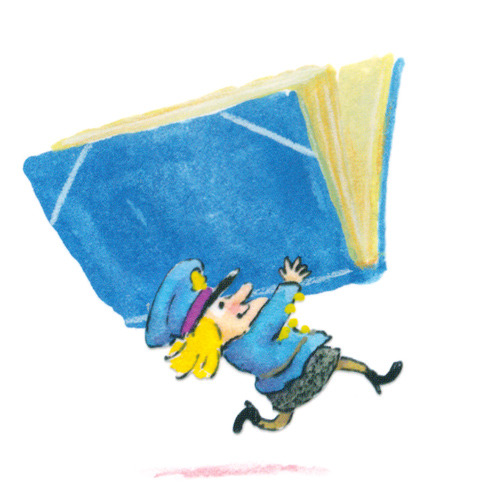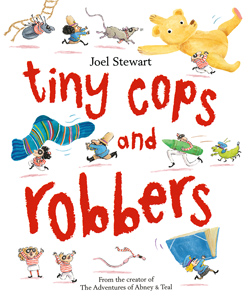< Back to posts
Joel Stewart
United Kingdom

Joel Stewart is an award-winning writer and illustrator who has illustrated books by contemporary authors such as Julia Donaldson and Michael Rosen, as well as classic texts by authors such as Hans Christian Andersen and Lewis Carroll. Joel is the creator/director of the hit children's animation series, The Adventures of Abney & Teal.
In this post, Joel talks about the creation of his latest picturebook, ‘Tiny Cops and Robbers’, and he shares some fantastic illustrations and work in progress. This brilliantly anarchic tale is published by Oxford University Press in the United Kingdom.
Joel: Hi there. ‘Tiny Cops and Robbers’, the picture book that I’ll mainly talk about here, is my fifth outing (I think) in picture books as both author and illustrator.
I’ve illustrated many others, written a couple of chapter books, and I co-wrote the 52 episodes of my animation series, The Adventures of Abney & Teal.
Here are some of the very earliest sketches I did for Abney & Teal. The show was a huge project, and drew heavily on all sorts of things from my childhood.
After the years spent making the show (which is really another story and which you can read about in the blog that I wrote for the BBC), I was pretty much burned out for a while. Though I never stopped drawing, making new books felt like a huge challenge. I can certainly get as frustrated as anyone both with writing and with drawing, and I can definitely go round in circles when it’s up to me to do both!
Usually, as in the case of both Abney & Teal and ‘Tiny Cops and Robbers’, I’ll begin with drawing. Playing both with the form and the content the way you can with a pencil is the closest thing I have to a sure-fire method for coming up with ideas.
With ‘Tiny Cops and Robbers’, I think that I drew a little robber character first. He seemed to be riding on something. I added a beetle underneath and there was the idea: a tiny robber! And of course, where there’s tiny robbers there must be tiny cops...
Then came a million different versions of the story, and all sorts of suggestions of the kind of thing it could be. To me, the fun was there in the initial idea, and I was interested in using archetypal characters almost like in a silent film (I suppose that kind of action often appeals to illustrators since it is such pure visual storytelling).
It’s actually too depressing to recount here all the different iterations of the story (long, short, rhyming, past, present etc, etc). The happiest of these ideas though was one suggested to me by my better half, who works as an editor of picture books (though not officially on this one!). This was the idea that the narrator could be the teddy bear who, in an earlier draft, was already being subjected to the indignity of being stolen, but who wasn’t telling the story.
I found this funny and it also gave a new level of emotional investment to what was otherwise just a caper. I’m glad that it allowed the rest to remain a simple story, set in a world with its own rules and action that appears to roll around night after night.
With the artwork, I had to piece some things together, partly because the story kept changing and partly because I‘d done a lot of line drawings on the computer that I liked but wanted to colour with real paint. So a lot of the black line drawings were drawn digitally and then printed (with pigment inks) onto watercolour paper for painting. The rest was painted separately with watercolour and gouache all in an effort to keep things lively and free. Then I scanned the various pieces and put them together in the computer. That balance of control and liveliness is what I’m always chasing. I pretty much got there in the end, though I’m sure there’s an easier way!
Before this book, I’d just had some experience doing a couple of things completely digitally, with brushes in Photoshop. Some of the simpler things turned out ok, but I was ultimately frustrated with the mark-making and energy of the drawing, and with working at a very different resolution to the finished printed image – which I blame for some rather odd compositions.
So for ‘Tiny Cops and Robbers’, I returned to making much more of the work on paper, and I was more satisfied with the images. (Incidentally, I try to avoid using the phrase ‘by hand’ when referring to work that isn’t done on the computer as I don’t do the digital work with my teeth!) As mentioned, working in bits was somewhat frustrating and long-winded in itself however.
Currently, I am working on various picture book ideas and black and white drawings for older fiction. One picture book that is quite far along is a sort of sequel to ‘Tiny Cops and Robbers’.
Since I finished Tiny Cops, I have been drawing a lot with an iPad Pro and an Apple Pencil. The software is in its infancy (I’m using two main programmes currently: ProCreate and Paintstorm Studio), but the feel has much more of the subtlety of working on paper, with the immediacy and control of working digitally. We’ll see what happens (hopefully there won’t be too many more hours just spent editing brushes!). I drew the line work this way for some illustrations for a new book by ‘Paddington’ author, Michael Bond. Again, I printed the line with pigment ink and added watercolour and chinagraph pencil.
I’m excited because I’ve just recently succeeded in making some art-quality, archival, pigment ink prints in colour onto paper that also works with paint and pencils, allowing me to get some finishing touches of real paint and pencils onto work that takes full advantage of the digital side.
Illustrations © Joel Stewart.
Tiny Cops and Robbers
Joel Stewart
Oxford University Press, United Kingdom, 2016
Wanted – the tiny robbers are on the loose! They are a mischievous lot, always looking for something they can take, especially if it's mummy's glasses, daddy's socks, or even grandpa's wig!
But don't worry, here come the tiny cops! They've polished their boots, shined their badges, and now they're ready for action! Which is a good thing, because the tiny robbers are after something really BIG this time!




















